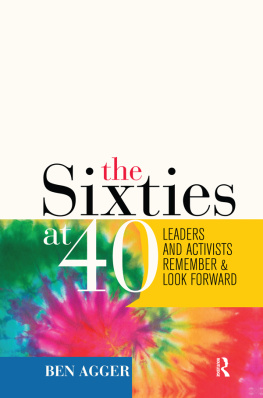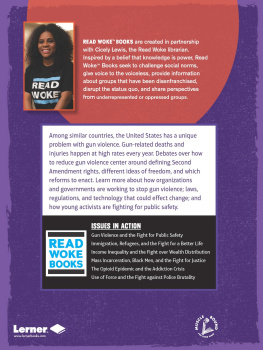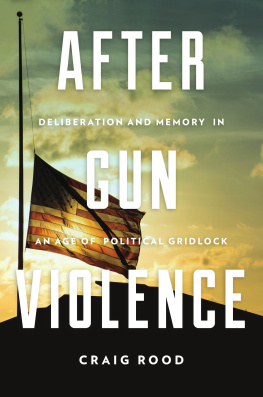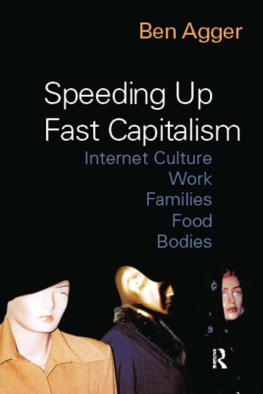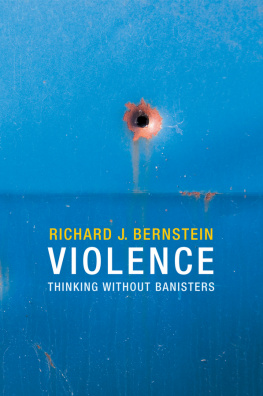First published 2014 by Paradigm Publishers
Published 2016 by Routledge
2 Park Square, Milton Park, Abingdon, Oxon OX14 4RN
711 Third Avenue, New York, NY 10017, USA
Routledge is an imprint of the Taylor & Francis Group, an informa business
Copyright 2014, Taylor & Francis.
All rights reserved. No part of this book may be reprinted or reproduced or utilised in any form or by any electronic, mechanical, or other means, now known or hereafter invented, including photocopying and recording, or in any information storage or retrieval system, without permission in writing from the publishers.
Notice:
Product or corporate names may be trademarks or registered trademarks, and are used only for identification and explanation without intent to infringe.
Library of Congress Cataloging-in-Publication Data
Gun violence and public life / edited by Ben Agger and Timothy W. Luke.
pages cm
Includes bibliographical references and index.
ISBN 978-1-61205-666-1 (pbk.: alk. paper)
1. Gun controlUnited States. 2. Violent crimesUnited StatesPrevention. 3. FirearmsUnited States. I. Agger, Ben, editor of compilation.
HV7436.G8765 2014
364.150973dc23
2013035490
ISBN 13: 978-1-61205-663-0 (hbk)
ISBN 13: 978-1-61205-666-1 (pbk)
THE PAST SEVERAL YEARS IN THE UNITED STATES HAVE BEEN MARKED BOTH by astounding violence and strong resilience. First, after surviving gunshots to her head and body in a January 2011 assassination attempt, US Rep. Gabrielle Giffords (D-AZ) announced her retirement from the House on January 22, 2012, so that she could concentrate on her long recovery from the wounds inflicted on her by Jared Lee Loughner, who killed six others in this rampage shooting. In a separate event, James Holmes opened fire in a crowded theater during a July 20, 2012, movie premiere in suburban Denver, killing twelve and wounding many others. On the morning of December 14, 2012, twenty-year-old Adam Lanza gunned down twenty first graders and six teachers at a Connecticut elementary school and then turned his gun on himself after murdering his mother in her bed at home. More recently, the world watched the trial of George Zimmerman, who was acquitted on July 15, 2013, by a jury of a murder charge for his role in the February 2012 killing of Trayvon Martin, an unarmed Florida teenager. In the wake of these high-profile incidents, the issue of guns in American public and private life has been pushed to the forefront. After the Newtown shootings, President Obama appeared to redouble his political efforts to push for new legislation requiring gun registration and limiting gun-magazine capacity. Meanwhile, gun-ownership pressure and interest groups have pushed back, insisting that the US Constitutions Second Amendment, which protects the right to keep and bear arms, is, and must remain at, the center of American liberty. An acrimonious national conversation over gun rights and gun control is ongoing, but it has so far only generated some heat, not much light, and no new legislation at the national level.
New restrictions were put into place in a few localities and states, like the enactment of limits on gun magazine capacities to fifteen rounds and the requirement of new background checks in private gun sales in Colorado. Passed by the Democratic Partycontrolled legislature during spring 2013, this success stirred an intense backlash by Colorado voters who have the power of recall under the states constitution. In a special recall election on September 10, 2013, the Democratic President of the Colorado Senate, John Morse (Colorado Springs), and a Democratic Senate colleague from Pueblo, Colorado, Angela Giron, were both recalled and replaced by Republican legislators. Their recall did not affect the overall balance of power in the states legislature, but it sent a very strong signal to other pro-gun legislators across the nation. If voters in the state where both the Columbine High School and Aurora movie theater gun rampages occurred were willing to oust lawmakers who worked hard to pass more restrictive new gun laws, then pro-gun interest groups made it clear that they would oppose all other legislators, judges, or officials who supported comparable moves anywhere else in the United States.
In this timely book, a group of US and international authors reexamine the complex and conflicted issues of gun violence in public life. Of particular interest will be comparative gun-homicide rates, the instructive case of Canada, the efficacy of existing gun controls, risks associated with gun ownership, concealed-carry gun-permit data and policies, the role of the mass media and computer game violence, masculinity/femininity and guns, school shootings, and the growing militarization of US police forces. While neither demonizing nor mythologizing guns, the assembled authors provide rigorous evidence-based analyses that work to shed light on possible policy directions. As social scientists, we are open to the counterintuitive and unanticipated dimensions of these topics, as deeper recurrent patterns emerge and what seems obvious often turns out to be false.
This book picks up where other earlier books on gun violence and school shootings leave off, including Katherine Katherine Newman et al.s Rampage: The Social Roots of School Shootings (2004), Dave Cullens Columbine (2009), and Doug Kellners Guys and Guns Amok (2008). Our book is distinctive because we examine sociological correlates and civic consequences of gun violence in the culture and society at large instead of dwelling on single horrific incidents such as Columbine. We do not rehash prior debates over the Second Amendment, but instead focus empirically on national and international (especially Canadian) gun-homicide rates and the effectiveness of gun controls. We also look at the incidence of violent gun crimes conceptualized (via the concept of risk) as a growing public-health problem, particularly for many municipalities where shootings are a leading cause of death for many young, male, minority, and urban populations, as well as a health hazard for women, children, and other family members. Finally, we introduce various alternative frameworks for thinking differently about gun violence, gun control, and gun use, each of which has strengths and weaknesses. From this evidence about the benefits and risks of guns in matters of human security, we tease out some policy implications, which include possibilities for pursuing both aggregate-level and individual-level reforms.
Given our academic backgrounds, it might be tempting for some readers to view this project as another simplistic jeremiad in favor of greater gun control, but we are not comfortable with that framing. One of our empirical conclusions is that many legislative efforts often are temporary remedies that are at best merely cosmetic measures or symbolic politics. There are deeper issues involved in the role of violence in public life, which resonate with the reasoned insights of the Founding Fathers, including Benjamin Franklin, who maintained that those who readily give up essential liberties to gain temporary security deserve neither liberty nor security. We are also not taking antiSecond Amendment stands in these analyses. We view the right to bear arms both historically and sociologically. This right is obviously not uncontested, and we recognize that the people who debate the appropriate capacity of gun magazines and the legitimacy of owning assault-style rifles cannot find much detailed guidance in the documents written by James Madison and Thomas Jefferson in the early days of the Republic. In response to a number of rampage shootings in the early 1990s, divisive and restrictive new gun laws were implemented in 1994 that built upon prior laws passed from the 1930s through the 1980s. Even with these stricter laws, however, limiting magazines, banning assault rifles, or establishing new background registries did not prevent mass shootings at Columbine, Virginia Tech, Aurora, or Newtown.




